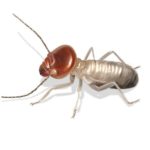There are many factors that influence how large termite colonies become. When attempting to determine where the most populous termite colonies are located, region is important, but it is not the only consideration. For example, the eastern subterranean termite damages homes from Florida to Maine, and their colonies can include around fifty thousand individual termites or more. However, Formosan subterranean termites live in colonies that can include millions of individual termites. The relatively huge size of Formosan termite colonies means that they damage homes at a much greater rate than all other colonies. Of course, these are only subterranean termites; dry wood and damp wood termite colonies also must be taken into account, as colony size differs from species to species. Generally, dry wood and damp wood termite colonies contain far fewer termites than subterranean colonies, some of which can contain less than one hundred individual termites. As a general rule, termite colonies are at their largest in equatorial regions, and they become progressively smaller as you move northward, away from equatorial regions.

Termites can form very large colonies, but determining the population level of a particular colony is sometimes difficult. This is because subterranean colonies can be interconnected over large distances underground. Sometimes a chain of colonies can continue for miles. So should such a chain be counted as one colony? Probably not, this is why experts do their best to define a colony’s barriers before determining their size in population.
Many people assume that subterranean termites form single colonies below the ground, but most of these colonies are connected to others. Colonies expand when worker termites venture away from the nest for food. If two worker termites from the same species encounter one another while foraging, they may fight or join forces. It is also not uncommon for one large termite colony to be surrounded by many smaller satellite colonies that are ruled over by members of the colony’s reproductive cast. It also takes around five years for a colony to mature, but this amount of time varies from species to species. Most mature subterranean colonies contain in between 200,000 and 2,000,000 individual termites.
If you had a termite infestation would you be curious as to how many individual termites were infesting your home?
Tags: Termite Control, Termites




